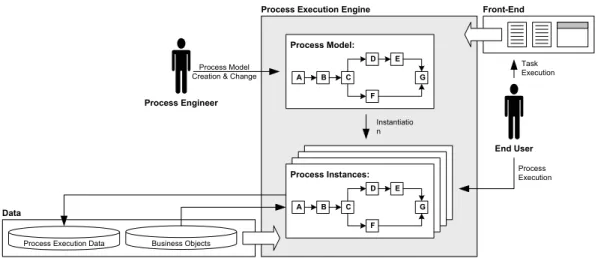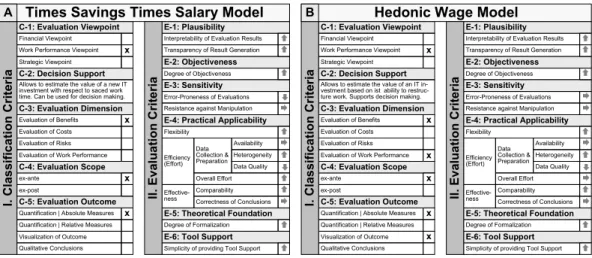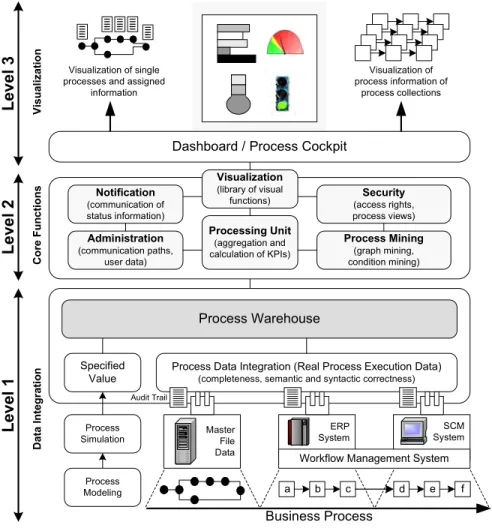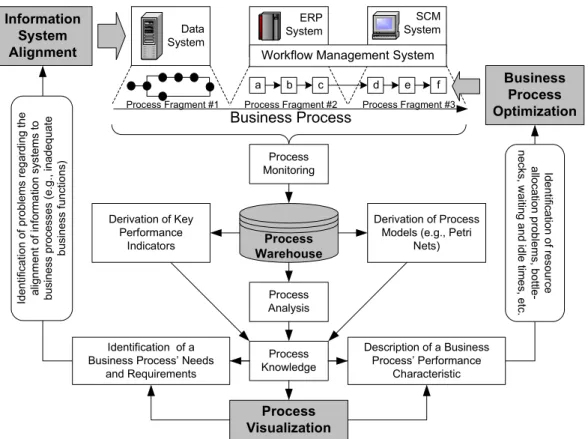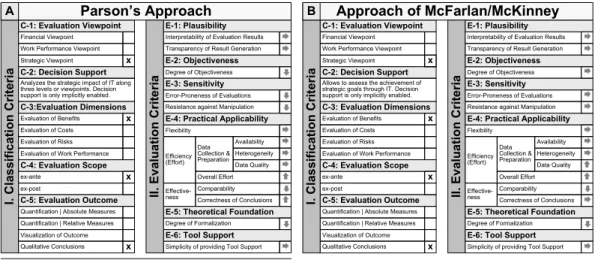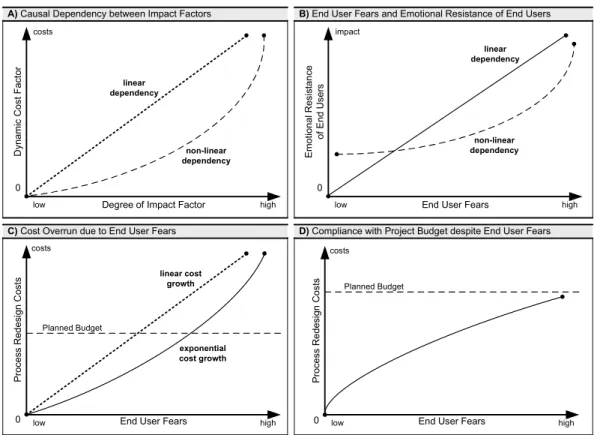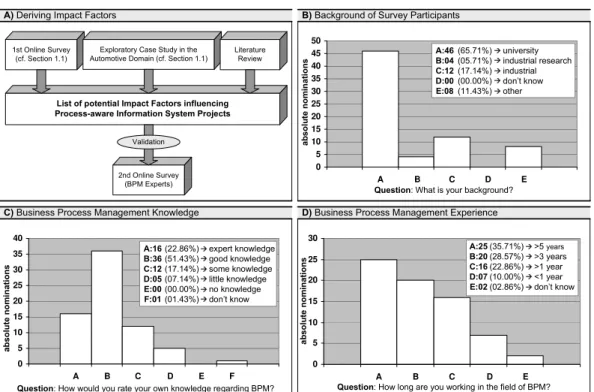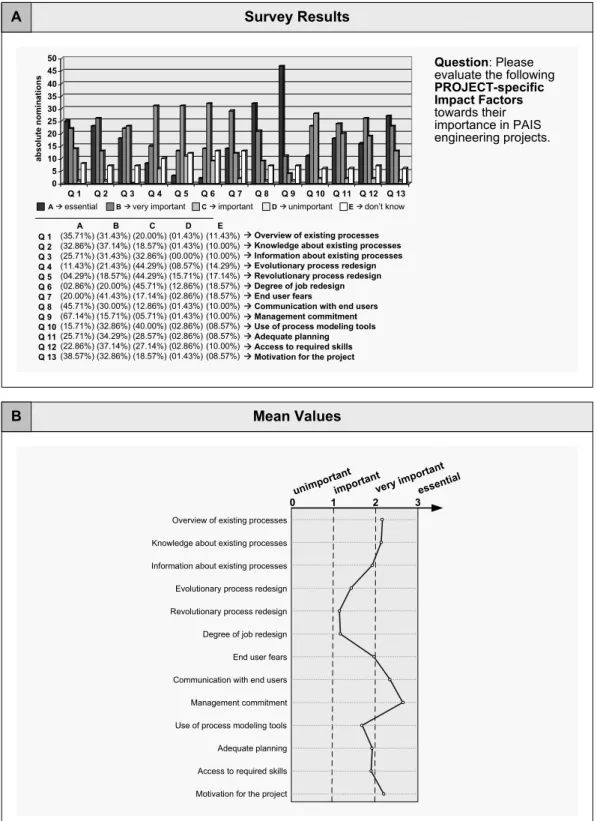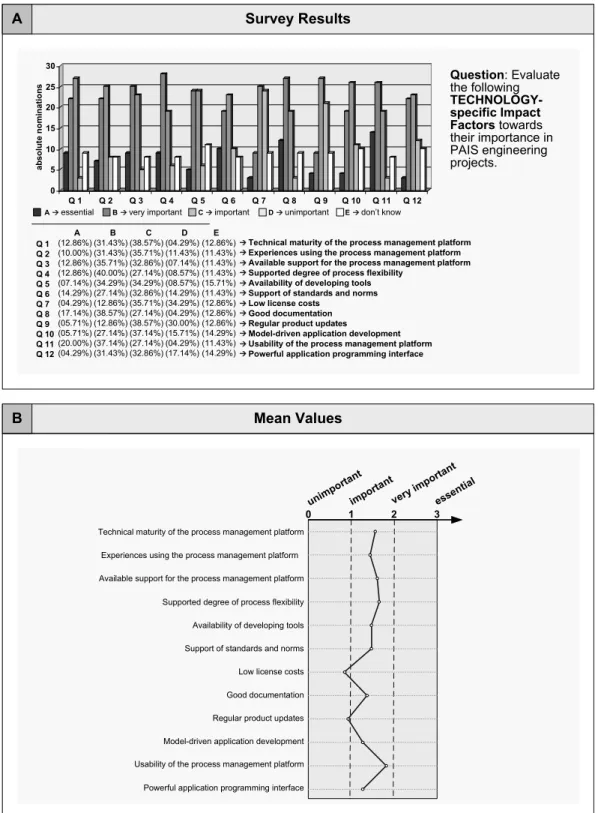PROCESS-AWARE INFORMATION SYSTEMS FROM A COST PERSPECTIVE
Bela Mutschler
Prof. dr. R. J. Wieringa, University of Twente, The Netherlands (promotor) Dr. M. U. Reichert, University of Twente, The Netherlands (assistant promotor) Prof. dr. J. van Hillegersberg, University of Twente, The Netherlands
Prof. dr. ir. M. Aksit, University of Twente, The Netherlands Prof. Dr. M. Nüttgens, University of Hamburg, Germany Prof. Dr. J. Becker, University of Münster, Germany Dr. J. Gordijn, VU University Amsterdam, The Netherlands Dr. F. Houdek, Daimler Group Research, Germany
SIKS Dissertation Series No. 2008-05
The research reported in this thesis has been carried out under the auspices of SIKS, the Dutch Research School for Information and Knowledge Systems.
ISBN: 978-90-365-2578-7
Copyright c2008, Bela Mutschler, Neu-Ulm, Germany English Correction: Renate McGrath (Vermont, US)
All rights reserved. No part of this book may be reproduced or transmitted in any form or by any means, electronic or mechanical, including photography, recording, or any information storage and retrieval system, without prior written permission of the author.
PROCESS-AWARE INFORMATION SYSTEMS FROM A COST PERSPECTIVE
DISSERTATION
to obtain
the doctor’s degree at the University of Twente, on the authority of the rector magnificus,
prof. dr. W. H. M. Zijm,
on account of the decision of the graduation committee, to be publicly defended
on Thursday 17 January 2008 at 16.45
by
Bela Mutschler
born on January 2, 1979 in Lindau am Bodensee, Germany
Dr. M. U. Reichert (assistant promotor)
Preface
Without my family’s support and continuous encouragement, it would have been impossible for me to get this far. In particular, I want to thank my wifeSimonefor her outstanding belief in my success and her perpetual support by keeping my back free.
I am also deeply grateful to my supervisor Manfred Reichert for being such a great mentor. Manfred, I really appreciated all the valuable advice you gave me in the last years.
You helped me through more than one fundamental crisis and always convinced me to go on. In particular, you gave me the necessary freedom for developing all my ideas.
Special thanks also go to my promotor Roel Wieringa for his valuable suggestions, ad- vice, and support during the last stage of writing my dissertation.
My special thanks also go toJohannes Bumillerfor his deep interest in my thesis. Jo- hannes, you helped me to come up with many good ideas and suggestions, to evolve them, and you gave me valuable advice whenever I needed it. The work with you forms one basis for the success of my thesis.
I also want to thank my partners at DaimlerChrysler, namelyBärbel Hörgerfor her con- tinuous support of my work, andMichael Offergeldfor the fruitful and pleasant cooperation and the level of responsibility he trustfully put on me in doing my research.
Finally, I also want to thank the following people for their support during the work on this thesis: Dr. Barbara Weber, Dr. Stefanie Rinderle-Ma, Novica Zarvic, Lianne Bodenstaff, Chen Li, Dominic Müller, Stefan Miller, Dr. Zlatko Zlatev, Dr. Ramin Tavakoli, Dr. Eduard Metzker, Heiko Ziegler, Dr. Axel Dold, Prof. Dr. Tobias Häberlein, Dr. Frank Houdek, Dr. Karin Schmidt, Carsten König, Michael Stupperich, Manuela Roos, Dr. Klaas Sickel, Dr. Pascal van Eck, Suse Engbers, Prof. Dr. Franz Schweiggert, Ulrich Kreher, Stanislav Pokraev, Peter Manhart, and Renate McGrath.
Abschließend möchte ich noch einige Dankesworte in deutscher Sprache anfügen, um mich auch bei denen direkt bedanken zu können, die nicht mit der englischen Sprache vertraut sind. Ohne die fortwährende Unterstützung meiner Familie – hier insbesondere meiner Frau Simone – hätte ich diese Dissertation nicht in dem mir selbst gesteckten Zeitraum beenden können. Simone war es die mir zu ihren Lasten den Rücken frei gehalten hat und die mir in mancher fundamentaler Krise immer beruhigend zur Seite gestanden hat.
Gerade auch mein 3-monatiger Aufenthalt an der Universität Twente im Frühjahr 2007, den meine Familie stillschweigend und ohne zu Murren als Notwendigkeit akzeptiert hat, hat einen entscheidenden Anteil an meinem Erfolg. Danken möchte ich auch meinen Eltern und Großeltern für ihre Unterstützung während der 3 harten Jahre als Doktorand.
Abstract
Providing effective IT support for business processes has become crucial for enterprises to stay competitive in their market. Business processes must be defined, implemented, en- acted, monitored, and continuously adapted to changing situations. Process life cycle sup- port and continuous process improvement become critical success factors in contemporary and future enterprise computing.
In this context, process-aware information systems (PAIS) adopt a key role. Thereby, organization-specificandgeneric process support systems are distinguished. In the former case, the PAIS is build "from scratch" and incorporates organization-specific information about the structure and processes to be supported. In the latter case, the PAIS does not contain any information about the structure and processes of a particular organization. In- stead, an organization needs to configure the PAIS by specifying processes, organizational entities, and business objects.
To enable the realization of PAIS, numerous process support paradigms, process mod- eling standards, and business process management tools have been introduced. The appli- cation of these approaches in PAIS engineering projects is not only influenced by techno- logical, but also by organizational and project-specific factors. Between these factors there exist numerous causal dependencies, which, in turn, often lead to complex and unexpected effects in PAIS engineering projects. In particular, the costs of PAIS engineering projects are significantly influenced by these causal dependencies.
What is therefore needed is a comprehensive approach enabling PAIS engineers to syste- matically investigate these causal dependencies as well as their impact on the costs of PAIS engineering projects. Existing economic-driven IT evaluation and software cost estimation approaches, however, are unable to take into account causal dependencies and resulting ef- fects. In response, this thesis introduces theEcoPOST framework. This framework utilizes evaluation models to describe the interplay of technological, organizational, and project- specific evaluation factors, and simulation concepts to unfold the dynamic behavior of PAIS engineering projects. In this context, the EcoPOST framework also supports the reuse of evaluation models based on a library of generic, predefined evaluation patterns and also provides governing guidelines (e.g., model design guidelines) which enhance the transfer of the EcoPOST framework into practice. Tool support is available as well.
Finally, we present the results of two online surveys, three case studies, and one con- trolled software experiment. Based on these empirical and experimental research activities, we are able to validate evaluation concepts underlying the EcoPOST framework and addi- tionally demonstrate its practical applicability.
Contents
Preface i
Abstract iii
I Introduction and Related Work 1
1 Motivation 3
1.1 Process-aware Information Systems . . . 4
1.2 Problem Statement . . . 9
1.3 Contribution . . . 12
1.4 Research Methodology . . . 12
1.5 Outline of the Thesis . . . 13
2 Related Work 15 2.1 Motivation . . . 15
2.2 IT Evaluation Terminology . . . 17
2.2.1 Costs . . . 17
2.2.2 Benefits . . . 18
2.2.3 Risks . . . 19
2.3 A Framework for Comparing IT Evaluation Approaches . . . 19
2.3.1 Existing Frameworks . . . 19
2.3.2 Our Comparison Framework . . . 20
2.4 Financial Viewpoint . . . 23
2.4.1 Static Measures . . . 24
2.4.2 Dynamic Measures . . . 25
2.4.3 Cost-oriented Approaches . . . 26
2.5 Process Viewpoint . . . 29
2.5.1 Times Savings Times Salary Approach . . . 29
2.5.2 Hedonic Wage Model . . . 30
2.5.3 Activity-based Costing . . . 32
2.5.4 Business Process Intelligence . . . 33
2.6 Strategic Viewpoint . . . 37
2.6.1 Nolan’s Approach . . . 38
2.6.2 Porter’s Competitive Forces Model . . . 39
2.6.3 Parson’s Approach . . . 40
2.6.4 Approach of McFarlan/McKinney . . . 41
2.6.5 Real Option Theory . . . 41
2.7 Software Cost Estimation Techniques . . . 42
2.7.1 Algorithmic Approaches . . . 42
2.7.2 Expertise-based Approaches . . . 43
2.7.3 Learning-oriented Approaches . . . 44
2.7.4 Regression-based Approaches . . . 45
2.7.5 Composite Approaches . . . 46
2.8 Other Approaches . . . 47
2.8.1 Value-based Software Engineering . . . 47
2.8.2 e3-value Framework . . . 48
2.8.3 Value-based IT Alignment . . . 48
2.9 Discussion . . . 48
2.10 Summary . . . 49
3 Requirements Analysis 53 3.1 Motivation . . . 53
3.2 General Requirements . . . 54
3.3 Specific Requirements . . . 57
3.4 Summary . . . 59
II The EcoPOST Framework 61 4 The EcoPOST Methodology 63 4.1 Motivation . . . 63
4.2 Basic Terminology . . . 63
4.3 The Methodology in a Nutshell . . . 65
4.4 Running Example . . . 67
4.5 Understanding the Evaluation Scenario . . . 68
4.6 Static Cost Factors . . . 69
4.7 Dynamic Cost Factors . . . 69
4.8 Impact Factors . . . 71
4.8.1 Identifying Impact Factors through a Survey . . . 72
4.8.2 Organization-specific Impact Factors . . . 73
4.8.3 Project-specific Impact Factors . . . 74
4.8.4 Technology-specific Impact Factors . . . 74
4.9 Evaluation Models . . . 79
4.9.1 Model Notation . . . 79
4.9.2 Illustrating Example . . . 81
4.9.3 Model Design Rules . . . 82
4.9.4 Model Validation . . . 86
4.10 Simulating Evaluation Models . . . 88
4.11 Deriving Conclusions . . . 89
4.12 Summary . . . 89
5 Simulating Evaluation Models 91
5.1 Motivation . . . 91
5.2 Need for Simulation . . . 92
5.3 Specifying a Simulation Model . . . 93
5.3.1 Constituting Elements . . . 93
5.3.2 Specifying SCFs and static ImFs . . . 94
5.3.3 Specifying DCFs and dynamic ImFs . . . 94
5.3.4 Specifying Rate and Auxiliary Variables . . . 96
5.4 Computing a Simulation Model . . . 101
5.5 Illustrating Examples . . . 102
5.5.1 Costs for Business Process Redesign . . . 103
5.5.2 Costs for Maintaining Process Logic . . . 104
5.6 Discussion . . . 108
5.7 Summary . . . 108
6 Evaluation Patterns 111 6.1 Motivation . . . 111
6.2 Primary vs. Secondary Evaluation Patterns . . . 111
6.3 Primary Evaluation Patterns . . . 113
6.3.1 Business Process Redesign Costs . . . 113
6.3.2 Process Modeling Costs . . . 115
6.3.3 Requirements Definition Costs . . . 116
6.3.4 Process Implementation Costs . . . 117
6.3.5 Process Adaptation Costs . . . 118
6.4 Secondary Evaluation Patterns . . . 119
6.4.1 End User Fears . . . 119
6.4.2 Process Knowledge . . . 120
6.4.3 Domain Knowledge . . . 122
6.4.4 Process Evolution . . . 124
6.4.5 Process Complexity . . . 125
6.4.6 Process Maturity . . . 126
6.4.7 Work Profile Change . . . 127
6.5 Customizing Evaluation Patterns . . . 128
6.6 Discussion . . . 130
6.7 Summary . . . 131
7 Methodology Governing 133 7.1 Motivation . . . 133
7.2 Guidelines for Designing Evaluation Models . . . 134
7.3 Guidelines for Developing Simulation Models . . . 136
7.4 Guidelines for Handling Dynamic Evaluation Factors . . . 138
7.5 Guidelines for Evaluation Patterns . . . 139
7.5.1 Identifying Evaluation Patterns . . . 140
7.5.2 Applying Evaluation Patterns . . . 141
7.6 Discussion . . . 141
7.7 Summary . . . 142
8 Tool Support 143 8.1 Motivation . . . 143
8.2 Tool Architecture . . . 143
8.3 The EcoPOST Cost Benefit Analyzer . . . 145
8.3.1 Cost Evaluations . . . 145
8.3.2 Benefit Evaluations . . . 146
8.3.3 Model Repository . . . 146
8.3.4 Business Ratios . . . 148
8.4 Summary . . . 149
III Validation 151 9 Model Validation through Experimental Research 153 9.1 Motivation . . . 153
9.2 Background Information . . . 154
9.3 Experimental Framework . . . 156
9.3.1 Basic Issues . . . 157
9.3.2 Experiment Design . . . 158
9.3.3 Risk Analysis . . . 159
9.4 Performing the Experiment . . . 161
9.4.1 Experiment Preparation . . . 161
9.4.2 Experiment Execution . . . 162
9.4.3 Data Analysis Procedure . . . 162
9.4.4 Results . . . 165
9.5 Discussion . . . 167
9.6 Related Work . . . 169
9.7 Summary . . . 170
10 Case Study 1: Process Design and Work Change 173 10.1 Motivation . . . 173
10.2 The Case Study . . . 174
10.2.1 Research Design . . . 174
10.2.2 Results . . . 175
10.2.3 Methodical Soundness . . . 178
10.3 Discussion . . . 179
10.4 Related Work . . . 180
10.5 Summary . . . 180
11 Case Study 2: Using EcoPOST in Practice 183
11.1 Motivation . . . 183
11.2 Background Information . . . 183
11.3 The Case Study . . . 184
11.3.1 Research Design . . . 184
11.3.2 Analyzing Process Management Costs . . . 187
11.3.3 Analyzing IT System Realization Costs . . . 190
11.3.4 Analyzing Specification and Test Costs . . . 193
11.4 Discussion . . . 195
11.5 Summary and Lessons Learned . . . 197
IV Discussion and Summary 199 12 Discussion 201 13 Summary and Outlook 211 Appendices 215 A Glossary 215 B Simulation Models from Chapter 6 217 Primary Evaluation Patterns . . . 217
Secondary Evaluation Patterns . . . 224
C Simulation Models from Chapter 11 233 Process Management Costs . . . 233
IT System Realization Costs . . . 236
Specification and Test Costs . . . 238
References 253
Samenvatting 255
SIKS Dissertation Series 257
List of Figures
1.1 The Business Process Life Cycle [200]. . . 3
1.2 Survey Background Information. . . 6
1.3 Degree of Process Support and IS Adaptation. . . 6
1.4 Process Changes. . . 7
1.5 Drivers of Evolution. . . 7
1.6 Considering Process Requirements. . . 8
1.7 Process-aware Information Systems. . . 9
1.8 The EcoPOST Research Plan. . . 11
1.9 Research Methodology. . . 13
1.10 Layout of the Thesis. . . 13
1.11 Answering the Research Questions: A Chapter-Oriented Overview. . . 14
2.1 The Curves of Technology Adoption. . . 15
2.2 Related Work at a Glance. . . 16
2.3 Different Types of Costs. . . 18
2.4 Our Criteria Framework at a Glance. . . 20
2.5 Combining Existing and New Criteria. . . 21
2.6 Accuracy of Estimations [29]. . . 22
2.7 Return on Investment and Payback Period. . . 25
2.8 Accounting Rate of Return and Break Even Analysis. . . 26
2.9 Net Present Value and Internal Rate of Return. . . 27
2.10 Zero Base Budgeting and Cost Effectiveness Analysis. . . 28
2.11 Total Cost of Ownership and Target Costing. . . 28
2.12 Times Savings Times Salary Approach and Hedonic Wage Model. . . 30
2.13 1st Work Profile Matrix. . . 31
2.14 Linear System of Equations. . . 31
2.15 2nd Work Profile Matrix (Changes = Gray Cells). . . 31
2.16 Activity-based Costing and Business Process Intelligence. . . 33
2.17 Reference Architecture for Business Process Intelligence. . . 34
2.18 Realization of BPI Benefits. . . 36
2.19 Applying Nolan’s Approach. . . 38
2.20 Nolan’s Approach and Porter’s Competitive Forces Model. . . 40
2.21 The Strategic Grid. . . 41
2.22 Parson’s Approach and the Approach of McFarlan/McKinney. . . 42
2.23 Algorithmic Cost Estimation Approaches. . . 43
2.24 Expertise-based Cost Estimation Approaches. . . 44
2.25 Learning-oriented Cost Estimation Approaches. . . 45
2.26 Regression-oriented Cost Estimation Approaches. . . 46
2.27 Composite Approaches. . . 47
2.28 Systemic Evaluation of PAIS Engineering Projects. . . 50
2.29 The Big Picture. . . 51
3.1 Deriving Requirements. . . 53
3.2 Requirements for Economic-driven IT Evaluation. . . 54
3.3 Developing a Business Case. . . 54
3.4 Pressure for Economic Justification. . . 56
3.5 Trustworthiness of Vendor Data. . . 56
3.6 Difficulties when Accomplishing Economic-driven IT Evaluations. . . 57
3.7 Requirements for the Economic-driven Evaluation of PAIS. . . 58
3.8 Derivation of Requirements: Four Pillars. . . 59
3.9 Identified Requirements at a Glance. . . 60
4.1 Terminology in the EcoPOST Framework. . . 64
4.2 Main Steps of the EcoPOST Methodology. . . 66
4.3 The EcoPOST Evaluation Philosophy. . . 66
4.4 Understanding an Evaluation Scenario. . . 68
4.5 Overview of Potential Static Cost Factors [25]. . . 69
4.6 Overview of Potential Dynamic Cost Factors. . . 71
4.7 Survey Background Information. . . 72
4.8 Organization-specific Impact Factors (Survey Results). . . 75
4.9 Project-specific Impact Factors (Survey Results). . . 76
4.10 Selected Organization- and Project-specific Impact Factors. . . 77
4.11 Technology-specific Impact Factors (Survey Results). . . 78
4.12 Selected Technology-specific Impact Factors. . . 79
4.13 Evaluation Model Notation and Initial Examples. . . 80
4.14 Dealing with the Impact of End User Fears. . . 82
4.15 Using Flows and Links in our Evaluation Models. . . 83
4.16 Examples of Incorrect Modeling. . . 84
4.17 Transitive Dependencies (Simplified Evaluation Models). . . 85
4.18 Interpreting Simulation Outcomes. . . 88
5.1 Step 6 of the EcoPOST Methodology. . . 91
5.2 Feedback in Evaluation Models – Overview of Potential Dynamic Effects. . 93
5.3 Elements of a Simulation Model. . . 93
5.4 Constant Equations. . . 94
5.5 Integral Equations. . . 94
5.6 Integrating the Net Flow of DCFs and dynamic ImFs. . . 95
5.7 Integral Equations (Examples). . . 95
5.8 Rate Equations. . . 96
5.9 Auxiliary Equation. . . 97
5.10 Auxiliary Variables for Representing Nonlinear Dependencies. . . 97
5.11 Specifying Table Functions and Reference Values inVensim[208]. . . 98
5.12 Table Functions for Quantifying Impact Factors. . . 99
5.13 Multiplicative and Additive Equation Formulation. . . 100
5.14 Computing a Simulation Model. . . 102
5.15 Evaluation and Simulation Model. . . 103
5.16 Simulation Outcomes. . . 103
5.17 Assumed Process Adaptation Costs. . . 104
5.18 Evaluation Model. . . 105
5.19 Simulation Model. . . 106
5.20 Simulation Outcomes. . . 107
6.1 Primary Evaluation Patterns. . . 113
6.2 Primary Evaluation Pattern: Business Process Redesign Costs. . . 114
6.3 Validating the Importance of Business Process Redesign. . . 115
6.4 Primary Evaluation Pattern: Process Modeling Costs. . . 116
6.5 Primary Evaluation Pattern: Requirements Definition Costs. . . 117
6.6 Primary Evaluation Pattern: Process Implementation Costs. . . 117
6.7 Primary Evaluation Pattern: Process Adaptation Costs. . . 118
6.8 Secondary Evaluation Patterns. . . 119
6.9 Secondary Evaluation Pattern: Dealing with the Impact of End User Fears. . 120
6.10 Validating the Impact of End User Fears. . . 121
6.11 Validating the Impact of Communication. . . 121
6.12 Secondary Evaluation Pattern: Process Knowledge. . . 122
6.13 Validating the Impact of Process Knowledge. . . 123
6.14 Secondary Evaluation Pattern: Domain Knowledge. . . 123
6.15 Validating the Impact of Domain Knowledge. . . 124
6.16 Primary Evaluation Pattern: Business Process Evolution. . . 125
6.17 Secondary Evaluation Pattern: Process Complexity. . . 125
6.18 Secondary Evaluation Pattern: Process Maturity (Continuous Representation).126 6.19 Primary Evaluation Pattern: Work Profile Change. . . 127
6.20 Step-by-Step Customization of Evaluation Patterns. . . 128
6.21 Merging Evaluation Patterns. . . 130
6.22 Related Issues in the Context of Evaluation Patterns. . . 131
7.1 EcoPOST Governance Guidelines. . . 133
7.2 Naming Feedback Loops (Simplified Diagrams). . . 135
7.3 Embedded Constants. . . 137
8.1 EcoPOST Tool Architecture. . . 144
8.2 Tool Support for Evaluation Scenarios. . . 145
8.3 Benefit Evaluation Module (Hedonic Wage Model). . . 147
8.4 Model Repository. . . 148
8.5 Net Present Value Module and Break Even Point Module. . . 149
9.1 The eTravel Business Process. . . 154
9.2 Data-driven Case Handling. . . 155
9.3 Selected Criteria for Comparing Workflow Management and Case Handling. 156 9.4 Single Factor Experiment. . . 157
9.5 Main Groups, Teams, and Students. . . 158
9.6 Experiment Design, Mathematical Model, and TimeCatcher Tool. . . 160
9.7 Performing the Experiment. . . 161
9.8 Distribution of Samples (Box-Whisker-Plot Diagrams). . . 163
9.9 Distribution of Samples (Scatter-Plot Diagrams). . . 163
9.10 Paired Comparisons. . . 164
9.11 Experiment Results (Overall Implementation Efforts). . . 165
9.12 Experiment Results (Base and Change Implementation). . . 166
9.13 Understanding Effort Distribution. . . 167
9.14 Selected Questionnaire Results. . . 168
9.15 Validation Effort Distribution for Process Implementation Costs. . . 169
9.16 Understanding the Distribution of Efforts. . . 170
10.1 Validating the Impact of Work Profile Change. . . 174
10.2 General Usefulness (Site 1). . . 176
10.3 General Usefulness (Site 2). . . 177
10.4 Impact on Job Dimensions (Site 1). . . 177
10.5 Impact on Job Dimensions (Site 2). . . 178
11.1 Automotive E/E System Development [122]. . . 184
11.2 The Business Case. . . 185
11.3 Data Collection (Information Sources). . . 186
11.4 Identification of relevant Impact Factors. . . 187
11.5 Process Management Costs (Evaluation Model). . . 189
11.6 Process Management Costs (Simulation Results). . . 191
11.7 IT System Realization Costs (Evaluation Model and Simulation Results). . 192
11.8 Specification and Test Costs (Evaluation Model and Simulation Results). . . 194
11.9 Efforts Caused by the new Process Designs. . . 196
11.10Efficiency of the new Process Designs. . . 197
12.1 Requirements at a Glance. . . 203
12.2 Experimental and Empirical Research in the EcoPOST Framework. . . 207
12.3 Software Technologies used Today and Tomorrow. . . 209
12.4 Evaluation of the EcoPOST Framework. . . 210
List of Tables
2.1 Business Process Intelligence Tools. . . 35
6.1 Merge Algorithm for Evaluation Models. . . 129
7.1 Guidelines for Designing Evaluation Models. . . 134
7.2 Guidelines for Developing Simulation Models. . . 136
7.3 Guidelines for Handling Dynamic Evaluation Factors. . . 138
7.4 Guidelines for Identifying and Applying Evaluation Patterns. . . 140
Introduction and Related Work
1
Chapter 1
Motivation
Providing effective IT support for business processes has become crucial for enterprises to stay competitive in their market [8, 43]. In the automotive domain, for example, a broad spectrum of business processes ranging from simple administrative procedures to complex, knowledge-intense engineering processes has to be effectively supported [101, 122]. Sim- ilar requirements exist in many other domains like finance [70], transportation [18], or healthcare [106]. All processes must be defined, implemented, enacted, monitored, and continuously adapted to changing situations. Thus,process life cycle supportand continu- ous process improvement adopt a key role in contemporary and future enterprise computing.
The process life cycle [200, 213] begins with thedesign phase, i.e., with the conceptual (re)design of a business process (cf. Fig. 1.1). Tools for modeling, analyzing, and mining are used in this context. Based on the chosen process design, the business process is imple- mented. As a result of thisimplementation phasewe obtain a process-orientedinformation system (IS) which provides business functions for facilitating the process. As a character- istic example of such an IS consider a product data management (PDM) system, which usually offers a broad range of business functions for the integrated support of engineering processes and product life cycle management [127]. In the automotive domain, such PDM systems are used to deploy models and documentation of vehicles (the managed product) to involved user groups (e.g., engineers, managers, suppliers).
Process Design
Process Implementation
Process Enactment Process
Diagnosis
Figure 1.1: The Business Process Life Cycle [200].
During the followingenactment phase, multiple instances of the implemented process are created and executed. Process enactment, in turn, results in a multitude of valuable real-
time process data that can be analyzed and evaluated in thediagnosis phase. Based on this, optimized business processes can be derived.
IS supporting the entire process life cycle are often referred to asprocess-aware infor- mation systems (PAIS). In general, PAIS orchestrate processes of a particular type (e.g., handling of a customer order) based on a predefined process model. Such a model defines thetasks to be executed (i.e., activities), their dependencies (e.g., control and data flow), the organizational entities performing these tasks (i.e., actors), and the business objects which provide or store activity data. Unlike conventional IS, PAIS strictly separate process logic from application code [160]. This provides promising perspectives, e.g., regarding the effective adaptation of process changes.
For implementing PAIS, numerous process support paradigms (e.g., workflow manage- ment [202], service flow management [107, 199], case handling [204]), process modeling standards [59] (e.g., EPC, WS-BPEL, BPML), and tools (e.g., ARIS Toolset, Staffware, Websphere) have been introduced. More precisely, build-time components support the (graphical) modeling of "as is" and "to be" processes as well as comprehensive process analysis (e.g., based on simulations). Run-time components, in turn, support the execution of processes and the analysis of process performance based on logged execution data [203].
Projects dealing with the introduction of PAIS are usually associated with high costs.
These costs are not only influenced by technological factors [202], but also by organiza- tional [102, 172, 173] and project-specific [15, 113, 210] ones. Hidden dependencies and interactions between the different factors result in additional, complex effects making cost evaluations for PAIS engineering projects a challenging task to accomplish. In particular, existing economic-driven IT evaluation approaches and cost estimation techniques are un- able to capture such effects as they mainly rely on static evaluation models.
What is needed is a comprehensive approach enabling PAIS engineers to systemati- cally analyze the complex causal dependencies between organizational, project-specific, and technological factors arising in PAIS engineering projects as well as their effects on project costs. In response to this need, this thesis introduces theEcoPOST framework.
1.1 Process-aware Information Systems
We will consider IT support for business process as being effective, if the following two goals are achieved: (1) the cost-effective implementation and customization of processes, and (2) the availability of a technical infrastructure supporting all phases of the process life cycle (cf. Fig. 1.1). In practice, however, many IS fail to provide effective business process support [52, 206, 225]. In order to better understand the rationales for this situation, we have conducted anexploratory case studyin the automotive domain. Results shall serve as further motivation for this thesis.
Exploratory Case Study. Over a period of three months we analyzed two characteristic automotive processes (a release management process and a data provision process) as well as their IT support (e.g., by a PDM system with more than 5000 users). We conducted 26 interviews with software developers, domain experts, and end users. Interviews were based
on a predefined, semi-structured protocol comprising two parts. The first one addressed the investigated process, whereas the second part dealt with specific problems of the supporting IS. Besides, we analyzed existing process documentation and organizational handbooks.
Altogether, we collected more than 120 shortcomings related to the development and operational use of the investigated IS. These included both organizational and technological aspects. Due to lack of space, we cannot present all of these 120 shortcomings in detail.
Instead, we summarize major results along five mainproblem areas[137]:
• Problem Area 1: Process Evolution. According to our case study, many problems are related to the evolution of business processes and their variability. In the analyzed domain, frequent process changes require the continuous adaptation of the supporting IS. However, realizing such adaptations is a difficult task to accomplish (cf. Problem Area 2 and Problem Area 3).
• Problem Area 2: Hard-coded Process Logic. The analyzed IS exhibit a "hard- coded" process logic, i.e., process logic is hidden in the application code and is not separately managed, e.g., by a workflow management system(WfMS). Each time a business process changes, deep inspections and customizations of source code mod- ules become necessary. This, in turn, results in large efforts and inefficient adaptation of IS to process changes.
• Problem Area 3: Complex Software Customizing. The analyzed IS are realized based on standard software components. Insufficient customization features of these components also result in an ineffective adaptation of process changes. In particular, existing software components lack possibilities to customize process logic at a suffi- ciently flexible and detailed level. This complicates the alignment of process-oriented IS to organization-specific requirements.
Besides these fundamental problem areas, we have identified two additional ones which are not directly related to the development of IS, but which can be linked to the elicitation and analysis of requirements prior to IS implementation:
• Problem Area 4: Inadequate Business Functions. Our case study reveals that pro- vided business functions do not effectively support business processes. Many of the implemented business functions are never used and are therefore without any "value".
Other business functions provide more functionality than actually needed. Also, busi- ness functions which are actually needed for process support are missing, making the automation of certain process activities impossible.
• Problem Area 5: Missing Process Information. Some of the analyzed IS log event- based process execution data or status information (e.g., related to the start and com- pletion of process activities). However, the structure of log data differs from system to system. Hence, keeping track of the processes or mining them generates large ef- forts (e.g., for normalize available data). In any case, missing process information makes it difficult to identify possible business process optimizations, process cycle times are longer than needed, and resources are not allocated in a cost-effective way.
In summary, our exploratory case study has provided initial insight into many practical problems related to the development and maintenance of process-oriented IS.
In order to investigate the most relevant results from our domain-specific case study in detail, we performed an additional online survey [94, 95, 96].
Online Survey. The survey does not only involve IT professionals from the automotive domain, but from other organizations and domains as well (cf. Fig. 1.2). 79 IT professionals (equating to a response rate1of 20.2%) have participated. See [136, 137] for details about the survey.
0 5 10 15 20 25
0 5 10 15 20 25 30
A B C D E F G H I J K L
A:01 (01.27%) telecommunication B:22 (27.85%) IT
C:22 (27.85%) IT consulting D:04 (05.06%) automotive E:00 (00.00%) aerospace F:03 (03.80%) pharmaceutical/chemical
G:02 (02.53%) engineering H:09 (11.39%) financial sector I :01(01.27%) energy sector J:01 (01.27%) service sector K:01(01.27%) industrial research L:11 (13.92%) other
absolute nominations
A B C D E F G H I J K L
absolute nominations
A:28 (35.44%) software development B:10 (12.66%) software maintenance C:08 (10.13%) operation D:08 (10.13%) administration E:02 (02.53%) controlling F:18 (22.78%) IT controlling
G:01 (01.27%) data center H:23 (29.11%) IT consulting I :18 (22.78%) IT management J:10 (12.66%) general management K:02(02.53%) industry science L:11 (13.92%) other
Industry Domains (2 Participants did not answer)
Working Areas (Participants are allowed to give several answers)
A B
Figure 1.2: Survey Background Information.
We first asked the survey participants whether the current degree of process-orientation is sufficient. 25.32% of the participants state that ISonly partlyprovide a sufficient degree of process-orientation (cf. Fig. 1.3A).
0 5 10 15 20 25 30
Question:Do process-oriented IS provide a sufficient degree of business process support?
A B C D E F
absolute nominations
A:01 (01,27%) yes B:25 (31,65%) largely C:23 (29,11%) indifferent D:20 (25,32%) only partly E:07 (08,86%) no F:03 (03,80%) don’t know
0 5 10 15 20 25 30 35
Question: Can process-oriented IS be adopted to evolving business processes quickly enough?
A B C D
A:02 (02,53%) yes B:22 (27,85%) largely C:18 (22,78%) indifferent D:32 (40,51%) only partly E:02 (02,53%) no F:03 (03,80%) don’t know
E F
absolute nominations
A B
Figure 1.3: Degree of Process Support and IS Adaptation.
8.86% even state that current IS do not provide a sufficient degree of process orientation at
1Mehta and Sivadas [115] describe that response rates for electronic surveys range from 40% to 64%. Bach- mann et. al [10] identify response rates of 19% for email and 46% for mail surveys. Falconer and Hodgett [62]
note that reasonable response rates for IS research are likely to be in the range of 10% to 35%. Thus, given the low response rates to IS and email surveys in general, and the large number of 29 questions, we regard the response rate to our survey as acceptable.
all. 29.11% of the participants consider the realized process support neither as problematic nor as advantageous. Only 32.92% of the participants consider available business process support as (largely or fully) sufficient.
One of the problem areas identified in our case study concerns process evolution (cf.
Problem Area 1). Survey results confirm that the need to continuously adapt IS to evolving processes constitutes a problem in practice. 43.04% of the respondents (cf. Fig. 1.3B) answer the question whether their current IS can be adopted to evolving business processes (and therefore to evolving requirements) quickly enough with no (2.53%) oronly partly (40.51%). Only 30.38% answer this question withyes(2.53%) orlargely(27.85%).
More than 90% of the participants agree that business processes changevery often,often orsometimes in their organization (cf. Fig. 1.4B). Additionally, 68.35% believe that the frequency of business process changes will increase in future (cf. Fig. 1.4B).
0 5 10 15 20 25 30 35 40
Question: How often do business processes change in your organisation?
A B C D E F
A:02 (02,53%) very often B:36 (45,57%) often C:36 (45,57%) sometimes D:04 (05,06%) rarely E:00 (00,00%) never F:01 (01,27%) don’t know
absolute nominations A
0 10 20 30 40 50 60
Question: Will the frequency of business process change increase in future when compared to today?
A:54 (68,35%) increase B:18 (22,78%) indifferent C:05 (06,33%) decrease D:02 (02,53%) don’t know
absolute nominations
A B C D
B
Figure 1.4: Process Changes.
We further analyzed drivers for process evolution. Participants state that the need forprocess optimization(65.82%) is the most important driver in this context (cf. Fig. 1.5). Others are organizational engineering (49.37%),laws and policies(46.84%), i.e., compliance issues, andmarket developments and dynamics(49.37%).
Question: What are factors leading to business processes evolution?
0 10 20 30 40 50 60
A B C D E F G H I J K L M N O P
absolute nominations
A:39 B:37 C:52 D:39 E:26 F:22 G:20 H:08 I :03 J:15 K:08 L:18 M:04 N:26 O:00 P:02
(49,37%) (46,84%) (65,82%) (49,37%) (32,91%) (27,85%) (25,32%) (10,13%) (03,08%) (18,99%) (10,13%) (22,78%) (05,06%) (32,91%) (00,00%) (02,53%)
organizational engineering laws and policies process optimizations market development & dynamics management order
change of enterprise goals new software technologies new hardware technologies compatibility with suppliers compatibility with customers norms and standards high process complexity low user acceptance quality program don’t know others (Participants are allowed
to give several answers)
Figure 1.5: Drivers of Evolution.
Besides, we also investigate the problem of inadequate business function support in more detail (cf. Problem Area 4). 45.57% of the respondents share the opinion that business process requirements (specifying which business functions are to be implemented) must be
considered when developing an IS (cf. Fig. 1.6A). 41.77% state that respective require- ments should be considered if possible. More precisely, 87.34% of the participants expect business process requirements to be considered when implementing an IS. However, and this is important, only 62.02% of the participants acknowledge that respective requirements are indeed (yesandlargely) considered when developing IS (cf. Fig. 1.6B).
0 5 10 15 20 25 30 35 40
Question:The requirements and needs of the business processes shouldbe considered when developing
respectively customizing process-oriented IS?
A B C D
A:36 (45,57%) yes B:33 (41,77%) if possible C:07 (08,86%) indifferent D:01 (01,27%) only partly E:01(01,27%) no F:01(01,27%) don’t know
E F
absolute nominations A
0 10 20 30 40 50
Question:The requirements and needs of the business processes are currentlyconsidered when developing
respectively customizing process-oriented IS?
A B C D
A:07 (08,86%) yes B:42 (53,16%) largely C:15 (18,99%) indifferent D:13 (16,46%) only partly E:00 (00,00%) no F:02(02,53%) don’t know
E F
absolute nominations
B
Figure 1.6: Considering Process Requirements.
Discussion. The results of both our case study and our online survey show that current IS are unable to provide business process support as needed in practice. In our case study, we have identified five major reasons for this drawback: (i) continuous evolution of business processes, (ii) hard-coded process logic of the supporting IS, (iii) complex software cus- tomization, (iv) inadequate business functions, and (v) missing process information. Our survey confirms these problems. Moreover, it provides further insights, e.g., into the drivers of process evolution or the compliance of IS with process requirements. Generally, these results show that the currently realized degree of "process-orientation" is scarce. Hence, en- terprises demand technologies which enable them to implement effective business process support. PAIS are such a technology.
Process-aware Information Systems. Our empirical studies indicate that providing effec- tive business process support by IS is a difficult task to accomplish. The currently realized degree of "process-orientation" in IS is by far not satisfactory. By contrast, enterprises more and more crave for approaches that enable them to improve their business process per- formance. Reflecting the aforementioned results, we conclude that conventional process- oriented IS are scarce. What we need instead are process-aware IS (PAIS), i.e., IS that support all phases of the business process life cycle.
PAIS can be implemented in two ways [59]: (1) by developing an organization-specific process support system, or (2) by configuring a generic process support system. In the former case, the PAIS is build "from scratch" and incorporates organization-specific in- formation about the structure and processes to be supported. As an example consider an enterprise resource planning(ERP) system. In the latter case, the PAIS does not contain any information about the structure and processes of a particular organization. Instead, an organization needs to configure the PAIS by specifying processes, organizational entities, and business objects. As an example consider the configuration of a WfMS.
In any case, PAIS strictly separate process logic (comprising the activities to be executed) from application code [55], i.e., PAIS are driven by process models rather than program code (cf. Fig. 1.7). They are realized based on process engines which orchestrate processes at run-time [160]. These process engines also provide an extensive library of process-oriented functions at build-time, e.g., for accomplishing automatic process analysis. Empirical stud- ies [99, 100] confirm that PAIS enable the fast and cost-effective implementation and cus- tomization of new and of existing processes (cf. Problem Areas 2 + 3).
Process Model:
A B C
D
F E
G
Process Instances:
A B C
D
F E
G Instantiatio n
End User
Process Execution Process Engineer
Process Model Creation & Change
Process Execution Engine Front-End
Data
Task Execution
Business Objects Process Execution Data
Figure 1.7: Process-aware Information Systems.
Realizing PAIS also implies a significant shift in the field of IS engineering [133]. Tradi- tional IS engineering methods and paradigms (e.g., procedural programming) have to be supplemented with engineering principles particularly enhancing the operational support of business processes. This is crucial to tie up those requirements that have been neglected by current process-oriented IS so far. However, such a shift is difficult to accomplish as software projects often use software technologies – at least today – that do not support the needed degree of process-orientation.
1.2 Problem Statement
Realizing PAIS is a complex task and PAIS engineering projects are usually associated with high costs [211, 222]. When evaluating these costs, a lot of PAIS-specific cost factors have to be considered which do only partly emerge in projects dealing with function- and data- centered IS. As examples consider costs for conducting interview-based process analysis (in order to elicit process requirements), costs for redesigning business processes and defining optimized processes, costs for creating process models and documentation, or costs for im- plementing the PAIS as well as process changes based on process management technology.
In order to justify these costs, it is often referred to assumed benefits of PAIS instal- lations, e.g., to improved process performance [45, 165], cheaper process implementation [99, 100], and gained process flexibility [66, 168].
However, though economic-driven IT evaluation and software cost estimation have received considerable attention during the last decades (cf. Chapter 2) – and have become an essen- tial task in IS engineering – it is difficult to apply existing evaluation techniques to PAIS engineering projects. This difficulty particularly stems from the inability of existing tech- niques to take into account the numerous technology-, organization-, and project-specific factors and their dependencies and interactions, which specifically arise in the context of PAIS engineering projects.
For example, activities forbusiness process redesign – as often conducted prior to the introduction of a PAIS – may be influenced by an intangible factor "Willingness of Staff Members to support Redesign Activities". Obviously, if staff members do not contribute to a redesign project by providing needed information (e.g., about process details), any re- design effort will be ineffective and will increase costs. If staff willingness is additionally varying during the redesign activity (e.g., due to a changing communication policy), busi- ness process redesign activities will be subject to even more complex effects.
What PAIS engineers need is a comprehensive approach that enables them to investigate such dependencies and their impact on the costs of PAIS engineering projects. Developing such an approach, a number of challenges have to be taken into account. First, we need to identify those factors that influence the costs of PAIS engineering projects. Second, we have to identify causal dependencies between these factors. This may be a difficult task to accomplish as these may not be transparent. Third, it is necessary to investigate the effects originating from these causal dependencies. Fourth, we need to analyze in which way this interplay is influencing the overall costs of PAIS engineering projects. Finally, we have to integrate all these issues into a comprehensive approach for deriving qualitative and quantitative conclusions.
Picking up these challenges, we define a number of research questions which guide the research described in this thesis (cf. Fig. 1.8 for a more detailed research plan). Thereby, we distinguish betweenknowledge problems(KP) anddesign problems(DP) [217]2:
• Research Question 1 (KP): What are existing approaches that can be used to evaluate PAIS? What are criteria that can be used to compare these approaches? Are existing approaches really suitable to evaluate PAIS engineering projects?
• Research Question 2 (KP): Which technological, organizational, and project-specific factors determine the complex cost structure of PAIS engineering projects?
• Research Question 3 (KP): Which relationships and causal dependencies exist be- tween these technological, organizational, and project-specific factors? How can the interplay of these technological, organizational, and project-specific factors be ana- lyzed? How can it be described?
2Aknowledge problemis a difference between what we know about the world and what we would like to know [216]. Knowledge problems can be solved by asking others, by searching the literature, or by doing research. Knowledge problems have stakeholders, namely the people who would like to acquire the desired knowledge. Research problems typically are knowledge problems in which we search for true propositions.
Design problems, in turn, are engineering problems, in which we search for an improvement of the world with respect to some goals. The evaluation criteria for answers to both kinds of problems are quite different:truthin the case of research problems,goal achievementin the case of design problems.
Q1. KP. What are existing approaches that can be used to evaluate PAIS?
KP. What kind of evaluation approaches exist?
KP. Which classification schemas exist for these evaluation approaches?
If there is no suitable classification schema:
DP. Design a classification schema.
KP. Validate the classification schema.
KP. Collect evaluation approaches from literature and classify them.
KP. How do these evaluation approaches compare to each other?
KP. What evaluation criteria exist for these approaches?
If there are no suitable evaluation criteria:
DP. Design evaluation criteria.
KP. Validate evaluation criteria.
KP. How suitable are these evaluation approaches for evaluating PAIS?
K What criteria for suitability are there?
If there are no usable criteria:
DP. Design criteria for suitability.
KP. Validate criteria for suitability.
Q2. KP. Which factors determine the complex cost structure of PAIS engineering projects?
KP. Collect cost and impact factors from literature.
KP. Collect cost and impact factors from the field.
DP. Design a questionnaire.
A. Collect data.
Q3. KP. Which relationships and causal dependencies exist between these factors?
How can the interplay of these factors be analyzed?
KP. Analyze potential relationships and causal dependencies.
A. Represent relationships and causal dependencies in evaluation models.
DP. How to build these evaluation models?
KP. What are guidelines for building these evaluation models?
A. Collect guidelines from the literature.
A. Collect guidelines from practical modeling experiences.
KP. Which modeling tools are available?
A. Select modeling tool.
DP. How to manage the models?
KP. What model management tools are available?
If no suitable tool is available:
A. Build model management tool .
A. Build evaluation models of the relevant factors using the guidelines and tools.
KP. Validate these evaluation models (respectively generate evaluation data).
A. Do a controlled software experiment.
DP. Design it.
A. Do the experiment.
KP. Analyze it (use data about different cost factors to validate and improve equations in relevant evaluation models).
A. Do a case study.
DP. Design it.
A. Do the case study.
KP. Analyze it (use data about different impact factors to validate and improve equations in relevant evaluation models).
Q4. DP. How can the plausibility of conclusions be ensured respectively improved?
KP. What are the guidelines for building models?
A. Collect lessons learned from your own modeling efforts.
A. Apply the approach in an industrial setting (action research; case study).
Explanation:
KP = Knowledge Problem / Knowledge Question A = Action / Research Activity
DP = Design Problem / Design Question
Research Plan
Figure 1.8: The EcoPOST Research Plan.
• Research Question 4 (DP): How can qualitative and quantitative conclusions regard- ing the costs of PAIS engineering projects be derived? How can the plausibility of conclusions be ensured respectively improved?
These research questions guide the research presented in this thesis. Note that Section 1.5 discusses which research questions are addressed in which of the following chapters.
1.3 Contribution
The contributions of this thesis are as follows:
• We identify a set of technology-, organization-, and project-specific impact factors which influence the costs of PAIS engineering projects.
• We introduce a comprehensive approach (called EcoPOST framework) for systemati- cally investigating causal dependencies and resulting cost effects in PAIS engineering projects. Our approach utilizes evaluation models and simulation and also supports the reuse of evaluation models.
• We describe a basic set of generic and customizable evaluation models calledevalu- ation patterns. Each evaluation pattern specifies one cost or impact factor and related causal dependencies in detail.
• Based on our experiences in applying the EcoPOST framework, we describe govern- ing guidelines enhancing the transfer of the EcoPOST framework into practice (e.g., model design guidelines).
• We present theEcoPOST Cost Benefit Analyzer, a tool which supports various ad- ministrative tasks related to the application of the EcoPOST framework. Among other things, this tool includes a model repository enabling the reuse of evaluation and simulation models.
• We illustrate how our evaluation models can be validated based on empirical and experimental research activities. More precisely, we describe the results of two online surveys, three case studies, and one controlled software experiment.
1.4 Research Methodology
Our research comprises four phases: (1)problem analysis, (2)requirements analysis, (3) solution design, and (4)solution validation and implementation evaluation(cf. Fig. 1.9).
We start with an analysis of the problem to be investigated (Phase 1). Related activities are an exploratory case study, an online survey, and a literature survey on IT evaluation ap- proaches and software cost estimation techniques. Note that results of the first two activities have been already discussed (cf. Section 1.1).
Based on these activities as well as based on practical experiences gathered in the auto- motive domain, we derive requirements for evaluating PAIS engineering projects from an economic-driven perspective (Phase 2). Taking identified requirements, we develop our solution approach, i.e., the EcoPOST framework (Phase 3).
Finally, we validate our framework based on a second online survey, two case studies, and a controlled software experiment (Phase 4).
Explanatory Case Study 2 Controlled Software
Experiment 48 Students Tool Support:
EcoPOST Cost Benefit Analyzer
Problem Analysis
Requirements Analysis
Solution Design
Solution Validation &
Implementation Evaluation
Literature Study:
IT Evaluation & Cost Estimation Techniques
Exploratory Case Study:
Automotive Domain
Online Survey #2:
70 BPM Experts Online Survey 1:
79 IT Experts
Explanatory Case Study 1
1 2 3 4
Conceptual Design of the EcoPOST Framework Literature Study:
Modeling &
Simulation
Explanation: Non-empirical activity Empirical activity
time
Figure 1.9: Research Methodology.
1.5 Outline of the Thesis
The remainder of this thesis is organized as follows. Part I unifies introductory chapters.
More specifically, Chapter 2 discusses related work (and therewith addresses the first of the identified research questions, cf. Section 1.2). Chapter 3 summarizes requirements for evaluating PAIS engineering projects from an economic-driven viewpoint.
Explanatory Case Study 2 (Chapter 11)
I. Introduction
II. Solution
III. Validation
IV. Discussion &
Summary
Requirements (Chapter 3) Related Work
(Chapter 2)
Model Simulation (Chapter 5) EcoPOST
Methodology (Chapter 4)
Summary &
Further Issues (Chapter 13) Motivation
(Chapter 1)
Discussion (Chapter 12)
Evaluation Patterns (Chapter 6)
Methodology Governance (Chapter 7)
Tool Support (Chapter 8)
Explanatory Case Study 1 (Chapter 10) Software
Experiment (Chapter 9)
Figure 1.10: Layout of the Thesis.
Part II of this thesis introduces the EcoPOST framework. Chapter 4 introduces the Eco- POST methodology. Chapter 5 deals with the simulation of our evaluation models. Picking
up the demand to reuse evaluation models, Chapter 6 introduces the notion of evaluation patterns. Chapter 7 deals with the governing of the EcoPOST framework. Chapter 8 de- scribes available tool support for the EcoPOST framework.
Part III of this thesis summarizes research activities which have been conducted to val- idate the EcoPOST framework. Chapter 9 illustrates – along a software experiment com- paring workflow and case handling technology – how experimental research can be applied for validating evaluation and simulation models. Chapter 10 also deals with model valida- tion, this time based on a case study investigating the correlation of PAIS and work profile change. Chapter 11 summarizes the results from a case study, in which we use the Eco- POST framework to investigate cost overruns in a large PAIS engineering project in the automotive domain.
Finally,Part IV discusses (Chapter 12) and summarizes (Chapter 13) the main contribu- tions of the thesis. Chapter 13 also gives an outlook on future work. Fig. 1.11 illustrates which of the defined research question is addressed by which chapter.
x
x x x x
x x x x x x x x x x x x x x
Chapter 1* Chapter 2 Chapter 3* Chapter 4 Chapter 5 Chapter 6 Chapter 8 Chapter 9 Chapter 10 Chapter 13*
* not relevant with respect to the defined research questions Chapters
I II III IV
Chapter 7 Chapter 12*
Chapter 11
Research Question 1 Research Question 2 Research Question 3 Research Question 4 Research Questions
Figure 1.11: Answering the Research Questions: A Chapter-Oriented Overview.
